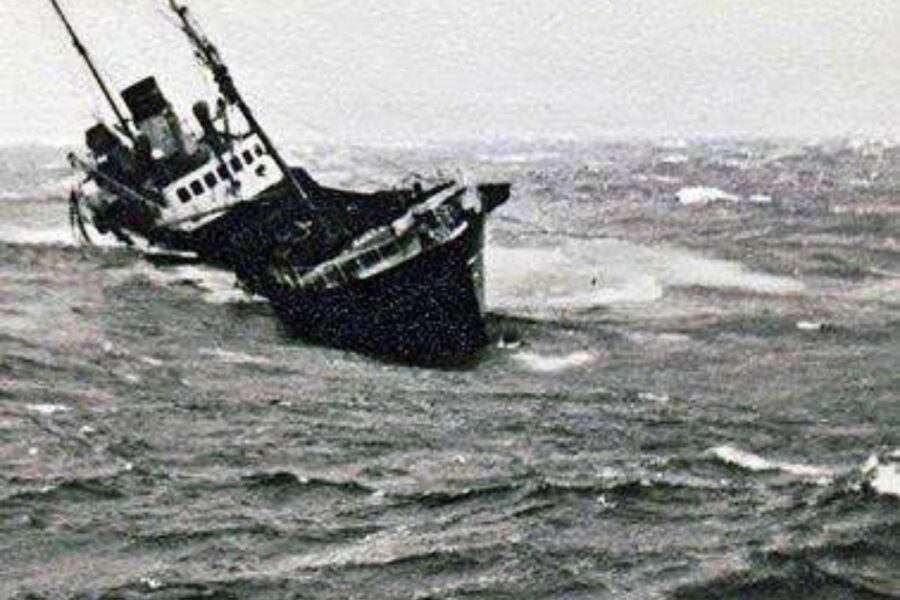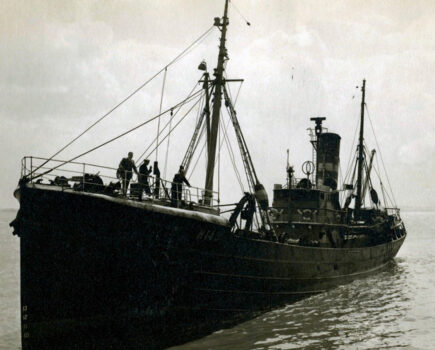Brian W Lavery looks back to 1960 when disaster struck the Hull trawler St Hubert, which sank after a mine caught in her nets exploded, killing four men…
It was 26 August, 1960, near Baatsfjord, off the Norwegian coast, and Skipper George Ness and his crew had had a great trip thus far.
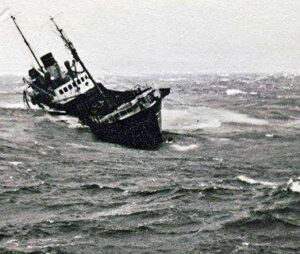
The abandoned St Hubert, minutes before she lurched violently and sank.
The hold was near-full, and the Hull sidewinder St Hubert H 142 would soon be homeward bound, looking forward to a bumper settling day, especially as they had sailed one man shorthanded – and slightly bigger crew shares therefore beckoned.
Skipper Ness reckoned they would be back in five days or so, weather permitting.
They had left Hull a couple of weeks earlier with 19 men aboard, one deckhand having failed to turn up for duty on the departure tide.
Two excited 14-year-old schoolboys were onboard too. For Alan Powdrell, it was his fifth ‘pleasuring’ trip. His big brother was the ship’s mate, Walter Powdrell.
In Hull’s Hessle Road fishing community, pleasuring trips were usually arranged by men whose sons, nephews or kid brothers wanted a taste of the trawlerman’s life, which for lads like Alan was a highly likely career path.
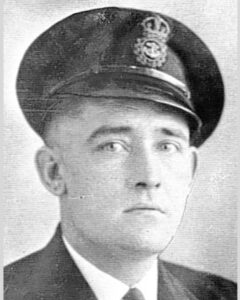
With the skipper and mate dead, bosun James Mullett took command of the St Hubert and kept her afloat against all the odds for more than six hours.
Alan’s pal Billy Wyng was his shipmate for this adventure. Billy’s big sister was married to Walter Powdrell. It was the lad’s first pleasuring trip.
‘Pleasuring’ was perhaps a misnomer, as the lads would certainly be put to hard, unpaid work.
The custom was that the crew would have a whip[1]round for the lads when the catch was landed. And fishermen with a bumper catch and the promise of a bonanza settling day could be most generous, especially after a few rums – so it could often be profitable for the lads.
It had been another good fishing day, and the winchmen were once again hauling a bulging net. Everything was going to plan for Skipper Ness.
The experienced deckhands could tell a heavy catch was coming – but when the net surfaced alongside, it became clear that there was something more than fish in there.
Once the haul had been carefully landed, they saw they had snagged a sea mine of some sort. It was approximately 5ft long, almost cylindrical, with one flat side cased in concrete.
The mystery device had fittings that showed that at one time it had been attached to an anchor. On its nose there was a detonator.

Prince Charles, the Hull trawler that came alongside to take the 17 surviving crewmen from the liferafts in raging seas.
Netting mines from the First and Second World Wars was not an entirely unusual event for trawlers of this era. Most experienced men had seen one netted at one time or another – or certainly knew someone who had.
These devices were usually dud, and although the men were not blasé about it, they were not too concerned to have it aboard.
Not long after the men of the St Hubert had dragged aboard their mystery mine, the Torquay Herald Express reported that a smaller trawler off the coast of Brixham had done likewise.
While fishing off Berry Head, the trawler Rodger Bushell radioed a report of a mine. Her skipper was told to ‘heave-to in Torbay’ and ‘not to approach Brixham harbour’.
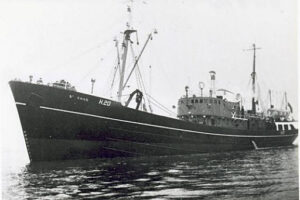
The St Chad brought the survivors safely to land.
A bomb disposal squad visited the trawler and confirmed the device was a dud. Skipper Harry Sutton then took it out to sea, where the First World War mine was dumped – and fishing resumed.
But there was no emergency service on call for Skipper Ness in Norwegian waters, so he decided to lash the mine forrad, with the intention of sinking it in deeper seas on the way home.
Ness, like many skippers before him, would have assumed this mine had lain at the bottom of the sea for decades, and was so decayed as to be harmless.
But he would also have been aware of some risk, which is why he intended to drop it off the edge of the continental shelf, so no other trawler would net it again.
Detonation
Three days passed after the mine was taken onboard. The vessel’s fish holds were now full, and the vessel was near Makkaur, on the Varanger peninsula. It was 11.45am on 29 August.
The weather had deteriorated, and gale force winds battered the St Hubert. The mine lashed forrad was taking that battering, too.
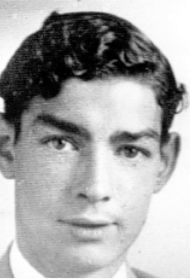
Twenty-five-year-old Walter Powdrell, mate of the St Hubert, was killed by the mine blast. His young brother and his wife’s younger brother were aboard.
The schoolboy sailors were below deck asleep – as were many of the crew, except those on watch and on deck.
The ‘sparks’ Jack Connaughton was in his radio room when the explosion tore through. He felt the vessel reel, and became aware that she seemed out of control. There was shrapnel everywhere.
The men on deck panicked as the blast tore holes in the vessel and sent debris flying. Deckhand Clifford Kane, mate Walter Powdrell and third hand Denny Bodham were killed instantly.
In the engineroom, chief engineer Kenneth Dewhurst saw the skylights blow out and the engineroom cast into darkness. He and his men fought to plug a massive hole in the port side of the vessel.
On the orders of bosun James Mullett, those below decks were putting on lifebelts and heading for the deck.
In the wheelhouse, Skipper Ness had suffered devastating facial injuries. He had lost an eye – but still managed to bring the vessel head to wind as blood poured from his wounds.
Minutes later, men carried the skipper to the chart room – but Skipper Ness insisted on being helped back into the wheelhouse. One of the men was later to say that the skipper looked as if he had ‘no blood left in his body’.
George Ness continued to ask after his men, and ordered that the liferafts be readied. But he had suffered massive blood loss, and was too weak to continue.
With the mate dead, command fell to bosun James Mullett. He had only minutes to assess what was happening. What followed was superlative leadership, courage and seamanship.
The panic on deck was overtaken by survival instinct, as the bosun’s attention turned to those below. There was a remarkable calm as he ordered the men to don their lifejackets and prepare the liferafts.
Bosun Mullett kept the St Hubert afloat for a little over six hours, but the blast had almost split her in two, and Mullett knew her fate was inevitable. It was a miracle that she stayed above the waves as long as she did.
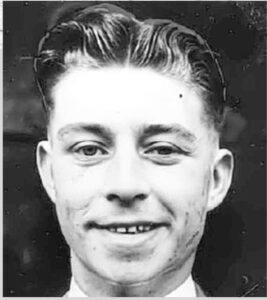
Third hand Denis Bodham was also killed instantly. No pictures were made public of deckhand Clifford Kane, who died in the blast, or skipper George Ness, who died of his injuries a few hours later.
Another Hull trawler, the Prince Charles, was by this time alongside, ready to assist. As Bosun Mullett gave the order to abandon ship, he felt her sink from under him.
The brave bosun managed to keep all his charges calm – even the frightened schoolboys. He decided not to tell them the fate of Walter Powdrell – Alan’s older brother and Billy’s brother-in law.
The survivors – 17 in all – transferred just in time to the liferafts and then onto the Prince Charles.
Skipper Ness died aboard the Prince Charles, just as his ship lurched violently and sank. His last words were of concern for his men. He had been reluctantly carried away from the vessel and crew that he had given his life trying to save.
‘Hurry to get home’
The surviving crewmen were later taken by another Hull trawler – the St Chad – to Kirkenes in northern Norway.
Here the 17, wearing clothes given to them by the men of the St Chad, were met by waiting emergency services – and the inevitable gaggle of reporters.
Bosun Mullett spoke with the international press agency Reuters and recounted the last hours of the St Hubert.
He said: “The object was like a cylinder but flat on one side, and was partly covered in concrete. There were fittings that seemed to indicate that it had been attached to an anchor – and there was a detonator on the nose.
“We were in a hurry to get home, with a good catch in the hold, and we stowed the object on deck.
“We thought it would be better to dump it in the sea when we were clear of the fishing grounds.
“There was a force eight gale blowing when I went below after the morning watch. I had been down about an hour when I heard the explosion. It was about 11.45 in the morning.
“When I ran up onto the deck, it was a shambles. “The whole port side rail was down. The hatches were blown open, and the whole foredeck was wrecked.
“The mate was killed, but his assistant Kenneth Peacham, only a couple of feet away, was all right.”
He went on to tell how he tried to keep the ship going alongside the Prince Charles, but had to give up as the weather worsened. “There was a terrible squall – up to force 10 – and I decided to run before the gale with the Prince Charles keeping near.
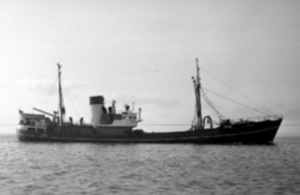
St Hubert H 142 was built in 1950 by Howaldtswerke in Kiel, Germany.
“We kept her going for about six hours, and then about a quarter to six I stopped her and gave the order to abandon ship.
“She practically sank under us.
We used inflatable liferafts to get away, and got aboard the Prince Charles. There was absolutely no panic.”
Skipper George Ness had fought to the end to stay with his trawler. “Captain Ness was onboard the St Hubert until she began to sink. We had to half carry and half drag him onto one of the rafts,” Bosun Mullett told Reuters.
Chief engineer Kenneth Dewhurst added: “I was in the engineroom when the explosion happened. I felt the shock. The skylights blew open and the lights went out.
“The motor kept going, but we stopped it while we tried to plug the hole in the port side of the ship.
“We then started to follow the Prince Charles, until after a few hours the boatswain shouted to us to abandon ship.”
Once at Kirkenes, four men were taken to the local hospital – one suffering from cuts and the others, including two young deckie learners, from shock.
Bosun Mullett told Reuters: “We have not told Alan yet that his brother was killed, but we shall have to do so this morning. It is a tragic business.”
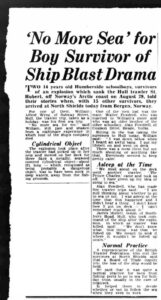
A contemporary interview in the Coventry Evening Telegraph with the 14-year-old schoolboys whose ‘pleasure trip’ ended in disaster.
A few days later, the survivors landed at North Shields, where they were met by a representative of the British Trawler Federation. They had been brought home on a mail boat from Bergen.
The two 14-year-old school pals whose ‘pleasure trip’ turned to tragedy spoke to reporters from the coach that had been hired to bring them home.
Young Billy Wyng, described as being ‘still pale and shaken’, told reporters: “No more sea for me.
“I was down below when I heard an awful bang.
“I put my lifebelt on and went on deck. There was a mess, but not much shouting or anything like that. Everybody seemed to keep pretty calm. We stood on the deck until another trawler, the Prince Charles, came along.
“I have given up any idea of going to sea now.” His pal Alan, who had now been told of his brother Walter’s death, said: “I can’t remember much about it.
“I don’t know how I got on the deck. I was asleep at the time this happened, and I didn’t hear a thing.”
Later that month, an inquest was held into the deaths of the four men who were killed in the St Hubert disaster. A verdict of death by misadventure was recorded.
Hull coroner Dr Philip Science said he wanted to place on record the heroic actions of the skipper and the bosun.
He also praised the ship’s cook William Adam, who discovered the terribly injured skipper.
In spite of the skipper’s awful, latterly fatal, injuries, he managed to set the ship head to wind and ordered the liferafts to be made ready. The cook and others then carried him to the chart room.
Mr Adam told the inquest: “I don’t think there was any blood left in his body. He kept on asking after the crew.
“He was carried into the chart room, but insisted on being taken back to the bridge.”
The courageous skipper died only 10 minutes after being brought aboard the Prince Charles – just as his own vessel went down.
Coroner Philip Science said: “Captain Ness’ conduct was in the best traditions of trawler fishermen, and the people in the city should be particularly proud.”
All photos by kind permission of the Hull Daily Mail archive.
This story was taken from the archives of Fishing News. For more up-to-date and in-depth reports on the UK and Irish commercial fishing sector, subscribe to Fishing News here or buy the latest single issue for just £3.30 here.

